You would have been hard-pressed to miss the massive excitement over hard seltzers (also called spiked seltzer, alcoholic seltzer, or hard sparkling water) over the past couple of years in the UK.
In addition, beer sales are declining in general, meaning breweries are looking to create new revenue streams, and hard seltzers are an easy option as they already have all the required facilities.
Market forecasts predicted massive growth in the sector saying, for example, that the UK hard seltzer market was expected to reach a value of £75m by 2023 (according to a report commissioned by DRTY, February 2021).
Despite continued interest and enthusiasm, the market is beginning to drop. It seems that the hard seltzer craze was over before it began. But why? And what are the lessons for entrepreneurs in the food & beverage sector?
What are brands allowed to communicate?
One of the clear advantages of drinking hard seltzers is that they have fewer calories than other alcoholic beverages.
The majority of hard seltzers come in a 12oz can and contain around 100 calories (a 12oz serving of craft beer can contain as much as 350 calories) and, although the amount of sugar varies between brands, it tends to be less than 3grams of sugar per serving. So, a hard seltzer could be considered a healthy option, if compared to beer, wine or fruity cocktails.
For the increasing number of health-conscious consumers, hard seltzers also tick a lot of boxes as they are generally low-carb, gluten-free and lower alcohol.
However, there is a BUT. UK brands selling hard seltzers are not allowed to make any health claims about their drinks, because they contain alcohol. There’ve been several complaints against hard seltzer brands upheld by the ASA (Advertising Standards Authority) for making stated and / or implied health claims, including Brewdog, DRTY, High-Water and Whisp.
Categories that boom in the USA can flounder in the UK
A lot of the projected success of the hard seltzer market in the UK has been based on the ongoing growth of the sector in the US.
And here comes another but: Often categories that boom in America flop here, for example Energy Shots. This is partly explained, as mentioned above, by the fact that in the UK we are far more limited as to what we can say about products. If you also consider that the UK population is far less familiar with what hard seltzers actually are, there will be a serious problem getting the message across to the consumer.
Therefore, consumers looking for ready-to-drink products are likely to buy canned or bottled beers, RTD cocktails or pre-mixed spirit and mixer cans, such as rum and coke or vodka and soda.
You can give consumers too much choice
Not long ago, several new hard seltzers were being launched every week. In my experience, too many brands in the same category confuse consumers. This leads to overwhelm rather than excitement.
Kombucha is a good example of where drinks brands should learn from the past and not have too many products on the market. There is so much white noise that when consumers enter an aisle in the supermarket and see, say, 60 different choices they either pick a brand that they know or, very often, enter another aisle for something else that they already know they like.
So, with start-ups wanting to launch a hard seltzer brand, my advice would be the same as it would be to someone looking at a kombucha: a fool and his money are easily parted.
The bigger players will take the spot, because consumers turn to what they know, and the smaller brands are then left with little opportunity to stand out from the mass.
Small setups vs international companies
Eighteen months or so ago, the trade journals were featuring just two or three hard seltzers. Initially they were being offered by small-scale entrepreneurs. But very soon the ‘big boys’ caught on, as they didn’t want to lose market share. This is the serious game-changer in this market. Once the big brands enter, the sector shifts – and it’s not always good news for the smaller entrepreneurs.
Forbes hit the nail on the head: “The massive growth of the global hard seltzer market is a Pied Piper call to numerous large brewers and other companies searching for bottom line profits.”
Smirnoff, Kopparberg and Coors have now all released their version of hard seltzers. The big, well-known brands are dominating the market and pushing their lesser-known rivals out.
Small brands are looking at competition with big budgets. This means if they want to stand out they will need to spend in the region of £100,000 just for marketing, and yet they will still be limited in what they can actually say. This is an enormous amount of money to spend and potentially lose if you’re a start-up, but a drop in the ocean for established, recognised brands to invest to ensure they don’t lose market share. It is so common for little brands to fail after spending all the money they have, leaving the market to the big brands such as White Claw.
It’s not that hard seltzer will completely disappear, rather it will be the small players who will suffer and ultimately wither, while the big boys take over and thrive. It is simply not worth it for small brands – they cannot compete.
Drink at home is very different to drinking out
We saw what happened when life began returning to normal, people were returning to their old drinking haunts and looking forward to the ‘experience’ that offers. The omicron variant is having an effect but looking ahead people will not go to bars, pubs etc. for a drink which is essentially ethanol with water and flavour and, even if they do, most bars don’t and won’t sell hard seltzers.
It’s like buying ready-to-drink coffee in Costa. They do not want to sell anything other than their own brand, which encompasses the experience as much as the end product. Consumers go to Costa for the experience as well as the coffee, they don’t want a RTD coffee, they want one that has been freshly made, to their specification, right in front of them. Likewise, people who enjoy a cocktail, want the experience of the cocktail. They want to order it and see it mixed and poured for them, not simply tipped from a can into a glass!
In my experience, brands often have to ‘incentivise’ an establishment to sell their product. I know a drinks brand that was told the manager would be happy to sell their products, but to gain approval from the owner and ensure the brand was listed, the owner insisted on receiving two first class tickets to New York, plus a stay in a swanky hotel while there!
Again, perhaps the big players are able to afford that, if they considered it worth the investment, but smaller brands certainly couldn’t and, even if they could, would still be unlikely to make profit from the result of that investment.
The craze is diminishing
Are hard seltzers an exciting development in the drinks market? Do they have a future ahead of them? I think not. As I had anticipated, forecasts are now saying that the hard seltzer craze is starting to diminish.
I’m not suggesting that entrepreneurs and start-ups should not consider launching an exciting innovative drinks brand; we are simply advising that as there could be better places to invest your energy, time and money than in a hard seltzer.
ABOUT THE AUTHOR
Richard Horwell is the owner of Brand Relations, a specialist food and drink marketing and branding company based in London. Over the last 13 years, Brand Relations has been behind the launch and development of over 100 brands in the UK. Richard has also built up and sold companies of his own in the Food and Beverage sector. He has over 30 years’ experience in marketing FMCG brands around the world, having lived and worked in the UK, USA, Australia and the Middle East.
https://www.linkedin.com/company/brand-relations-ltd/
https://www.instagram.com/brandrelations/
https://www.facebook.com/brandrelationsltd
References:
https://marksdmw.com/can-a-brewery-make-hard-seltzer/
Richard Horwell
- Richard Horwell#molongui-disabled-link
- Richard Horwell#molongui-disabled-link
- Richard Horwell#molongui-disabled-link






